MechSE's Ewoldt Brings Rheology Down to a Level Learners of All Ages Can Grasp
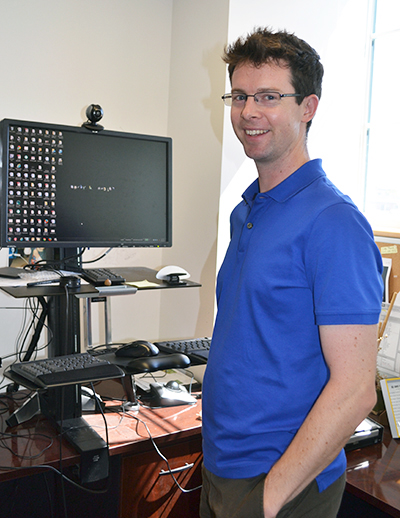
MechSE Assistant Professor and Rheology guru Randy Ewoldt
October 6, 2014
"If you really understand something, you can explain it to somebody else in a simple enough way to bring it down to their level, wherever that level might be." – Randy Ewoldt
And what Assistant Professor Randy Ewoldt of Illinois' Department of Mechanical Science and Engineering understands really well is fluid mechanics, particularly rheology. Bringing it down to a level most folks could understand, he defines it as: "the study of how things squish and deform when you push on them."
Ewoldt is particularly interested in non-Newtonian fluids. The name refers to Sir Issac Newton, the 17th Century scientist, who, according to Ewoldt, "first described a law for how simple fluids like water and oil flow. So-called “non-Newtonian” fluids break that law: they can bounce or be stretchy, for example."
One ubiquitous non-Newtonian fluid, which shows up in practically every campus STEM outreach event, is oobleck, which appears to be a liquid when, say, held loosely in one's hand, but can also act like a solid when force or pressure is applied.
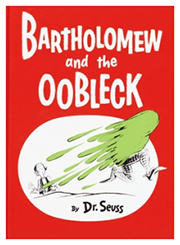
The Dr. Seuss book, Bartholomew and the Oobleck, that made oobleck famous (Image courtesy of Wikipedia)
Modern-day oobleck inherited its name from the slimy green non-Newtonian substance that fell from the sky in place of rain in Dr. Seuss' Bartholomew and the Oobleck. But while no one is sure what its famous namesake was supposedly comprised of, today's oobleck (according to Google) is usually made from water and cornstarch.
But while oobleck is fun to play around with, it isn't the only non-Newtonian fluid out there.
"A lot of materials behave in these weird ways," stresses Ewoldt, "so you can't just look at one material and get an understanding of how weird things can be."
He submits that many less familiar non-Newtonian fluids could potentially have some practical uses, such as in firefighting, manufacturing, inkjet printing, and agricultural spraying. However, the first step is to better understand how they work. So Ewoldt proposed and earlier this year was awarded a National Science Foundation Career grant: Thixotropic Yield Stress Fluids—Splashing, Spreading, Sticking, which will involve both research and education.
His vision for the research is to understand these materials enough to design things with them. "So you've got all this cool functionality," says Ewoldt. "It's hard enough just to think about these materials, let alone be creative on top of understanding the materials to do something cool with them."
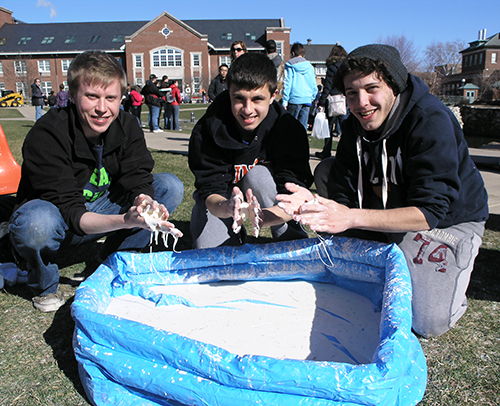
Illinois students at a recent Engineering Open House play with a non-green variety of oobleck to demonstrate some of its more interesting properties.
The bigger, long-term vision is to gain enough understanding to be able to think creatively about using these in real applications. "My educational mission would be to accelerate that understanding," says Ewoldt, "because you have to go through all of that before you can, with proper understanding, start applying it creatively.
While Ewoldt finds his research on rheology fascinating, he also loves to teach about it. Even during the interview for this article, he couldn't help himself, and gave this reporter a mini-lesson. He explained that viscosity correlates with resistance to flow. "Honey has a higher resistance to flow than water," clarifies Ewoldt, "so honey has a higher viscosity." This reporter also learned that shear is a relative sliding motion caused when gravity applies stress. At one point Ewoldt even jumped up to his whiteboard to draw a model of force and displacement while briefly explaining about his big idea concept for TAM 251, the introductory solid mechanics course he teaches.
Ever the teacher, Ewoldt effortlessly distills aspects of his research down into everyday terms that pretty much anyone, even a reporter, can grasp. For example, for one instrument that's key to their research, a rheometer, he gives a picturesque metaphor explaining how it works.
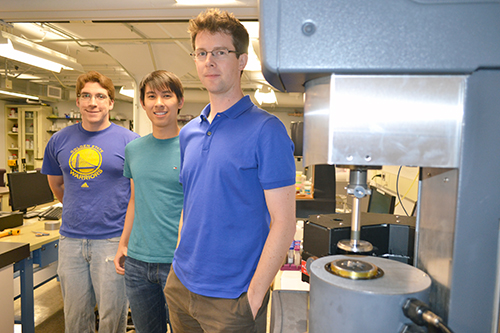
Right to left: Randy Ewoldt and two of his students, undergrad Alex Wu and graduate student Brendan Blackwell, by one of the rheometers they use in his Rheology Lab.
"Picture an oreo cookie. The cream of the cookie would be the thing you're interested in. So we have very expensive scientific instruments that act like an oreo cookie test, where you twist one of the cookies; see, you twist one of the plates, and the material in between can be measured based on how far it moves when you push on it."
Clearly a born teacher, Ewoldt has always loved teaching, even as a child, and particularly embraces a challenge—and the tougher the audience, the better.
He relates an anecdote about teaching people to play the card game Euchre, when he was a kid. "I loved teaching this game because I had so many people who said, "I don't like that game; it's too complicated. My dad tried to teach me as a kid, and it was a mess!' I'd always take that challenge and say, "Give me three minutes!' And just the way that I like to teach, I like to think about the big idea before getting into all of the details. And every time I had a success, I would…"
(Then, just like a gunslinger in the old West would carve a notch in his holster, Ewoldt wets his finger and, complete with an apropos whistling sound effect, tallies another "1" in the air on the imaginary record of teaching successes he's evidently been keeping since he was a kid.)
"...A mark of pride that I could find some way to reduce it down," he finishes.
Shamelessly using a captive audience to run up his score, he also practices his teaching skills on his kids, who are 7 and 3½. "It's such a fun challenge and joy to try to talk to them about what Daddy does for research," admits Ewoldt.
So do his kids understand about non-Newtonian fluids? "You know, it's funny," he says. "I don't use that word with them, because they don't need the word yet. But squishy materials, funny liquids, you have to bring it to their level where it makes sense. But they could probably give you examples of weird materials that Daddy works with."
Ewoldt admits that, no matter the age or educational level, part of the fun of teaching is the challenge of distilling material down into the big idea.
"So I like those challenges," he admits. "And I think that that carries over into teaching anybody, whether that's a child or an adult who doesn't have a technical background...but also translates even to high-level graduate students who are learning something that is very complex. We have these thick textbooks with complicated equations," but says that, even then, he starts with: "What's the big idea of this equation?"
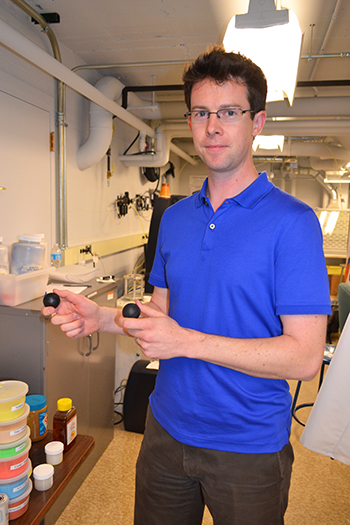
Randy Ewoldt holds two two balls that are part of his Rheology Zoo. While they look exactly the same, because they're made of different materials, they have different properties; one has a lot more "bounce" than the other.
Also a big fan of hands-on learning, Ewoldt believes learners of all ages can benefit from it. While most are either visual, aural, or tactile learners, he says teachers typically address the first two, but often neglect the third.
"Because we speak, and we write things down in the lecture hall, but we're not usually grabbing onto things. Some people aren't tactile learners...but it's missing so much that everybody can usually benefit from being tactile."
So to ensure that his educational efforts include a hands-on dimension, Ewoldt has assembled a "Rheology Zoo," a wild and wonderful assortment of non-Newtonian fluids: "You look at Oobleck, and that's cool, but it's such a complex world of many other things, that it doesn't really give you all the creative space that you might actually want if you are to do something cool with these fluids," he says.
One use of the Zoo is for outreach. "I'll bring a row of containers," says Ewoldt, "and I'll pull out different materials to show people how weird things can be, and talk about why it's there."
However, Ewoldt even has students in his lab use the Zoo "to accelerate their understanding, with the idea that the tactile feeling of all of these things will help them get a much better feel for the material." He believes that, in addition to measuring the properties of different materials, handling them is still a critical learning tool. "To be able to correlate what you are measuring with the number you see on the instrument with how it actually feels is a pretty important bit of intuition to know how to design with these things," acknowledges Ewoldt.
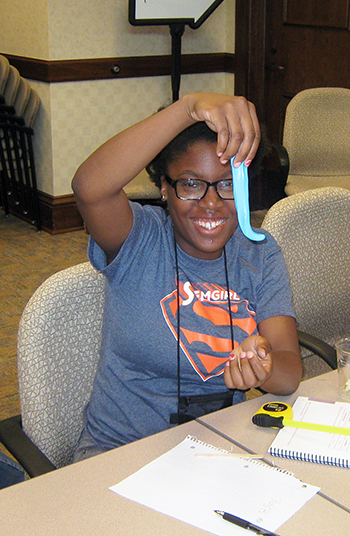
A Summer 2014 GBAM camper appreciates the unique properties of one of the materials in Ewoldt's Rheology Zoo. (Photo courtesy of MechSE's Samantha Knoll.)
So the Zoo gives students the opportunity to touch these unique materials. "That's kind of the first layer of this educational thing; the hands on, "Here are some materials just to play around with.'"
But his vision for the Zoo's usefulness goes beyond just hands-on. He hopes to develop a card for each material so students can understand its weird behavior on a microstructural level. Ewoldt envisions students' thought processes: "So why does this material behave like this? Is it at an atomic or molecular level? Is it at a larger level than that?" The card would also include a picture of starch molecules, as in the case of oobleck, to show students why the material behaves like it does, plus instructions that take students to an even deeper level by showing them how to measure something that correlates with what they see.
How mobile is the zoo? Since rheometers are too expensive to cart around, initially, they've been doing things in-house, such as at the EOH in spring 2014, and in MechSE's open house on October 17, 2014.
"Our vision is to gradually build this up," says Ewoldt. "These are really great opportunities to 'play test' all of these ideas in front of an audience, where you can get the feedback and refine these things."
He also did some "play testing" this past summer during MechSE's G-BAM G.A.M.E.S. camp. They had the high school girls do "an activity related to formulating weird, stretchy, squishy material in kind of a design context, which was pretty cool," relates Ewoldt.
He envisions eventually making available instructions on how to assemble a do-it-yourself "Rheology Zoo." After he and his students figure out "What would the right collection be to represent this broad spectrum of rheological behavior?" they would then write up a recipe book for making or buying "weird toys" like playdough, silly putty, etc., then find some way to distribute it.

Ewoldt demonstrates the unique properties of a non-Newtonian fluid from his Rheology Zoo during the session at the GBAM G.A.M.E.S. camp in summer 2014. (Photo courtesy of MechSE's Samantha Knoll..)
What about coming up with practical uses for these unique materials? Ewoldt is not neglecting this part of his mandate. With a myriad of STEM units on campus to choose from, Ewoldt has an ongoing collaboration with, of all places, the School of Art and Design.
He somehow connected with a faculty member, Cliff Shin, who teaches industrial design. His students design products based on the form, shape, color, and how a person interacts with a product, and the main project for one of his classes is product ideas based on funny fluids. So Ewoldt gives a guest lecture similar to Rheology Zoo outreach, then the students come up with designs for interesting products, ways to use materials with weird behavior…which may come in handy down the road when Ewoldt has figured out exactly how his fluids work and is looking for additional applications.
Above all, Ewoldt wants learning to be fun. Evidently during the recent ALS Ice Bucket Challenge, he was challenged by a colleague at BYU, whom he one-upped by doing it in slow motion with a water balloon. Ewoldt's students set him up on Engineering Quad and, using the color high speed camera from their lab, recorded popping the balloon over his head, then posted the video slowed down 100x. Ewoldt then challenged his Ph.D. advisor at MIT, who, of course, one-upped him, doing it with non-Newtonian fluids.
"We like to be creative," he declares. "I think that students pick up on that."
Story and photos by Elizabeth Innes, Communications Specialist, I-STEM Education Initiative.
More: Faculty Feature, G-BAM, MechSE, 2014













.jpg)
















